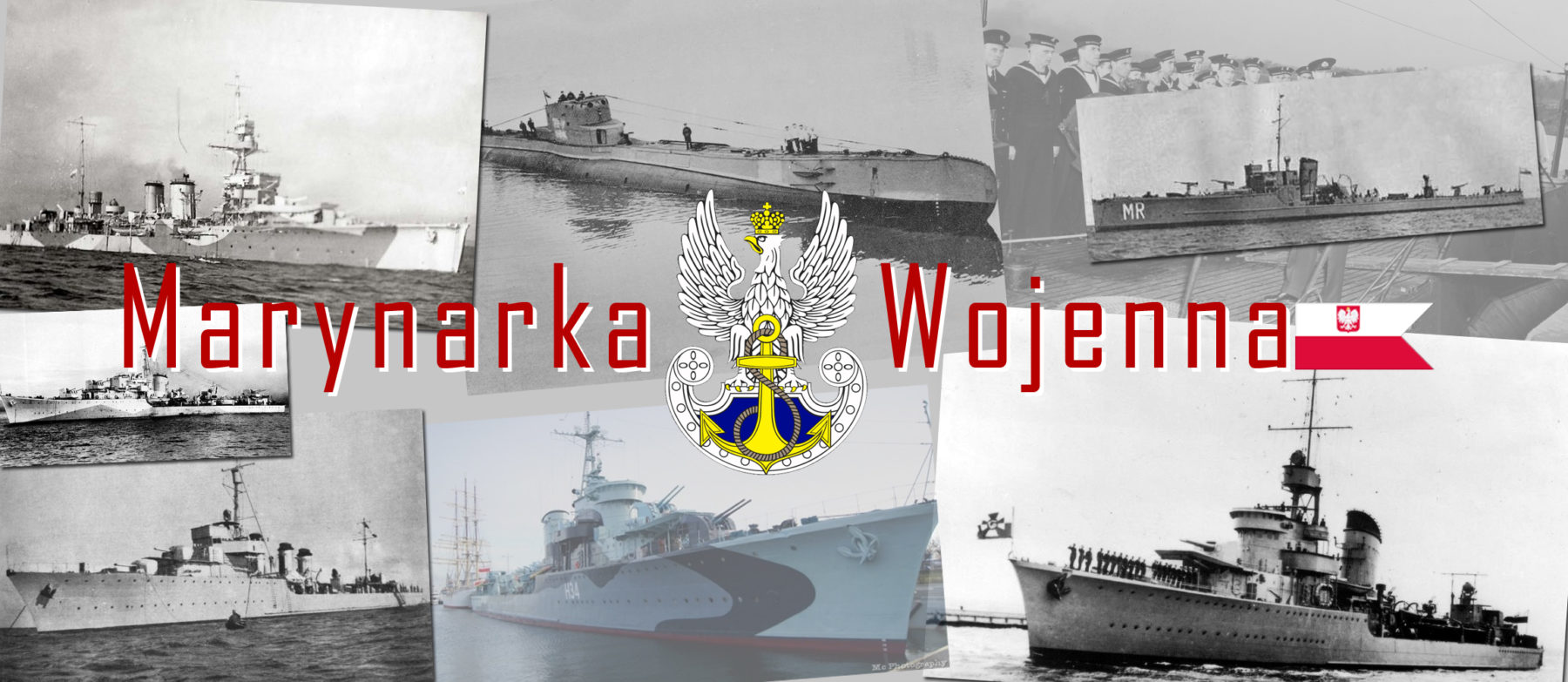
 Marynarka Wojenna – 31 ships in WW2
Marynarka Wojenna – 31 ships in WW2
Poland has experienced many territorial vicissitudes in its history, wedged between its bulky Germanic neighbors and the Russian Empire, and threatened in the south by the Turkish advance, it has developed a rich and ancient maritime culture. While it is well known that the Venetians have been great maritime navigators since the end of antiquity, it is lesser known that the Eastern Scandinavian sailors and traders have much to do with the techniques developed by these navigators.
A commercial powerhouse of the Baltic, Poland once had a fleet of impressive trade carracks in the XV-XVI centuries, including the huge “Peter of Gdansk”. The know-how of the Polish shipyards is still recognized today in the world, and their remaining geopolitical importance can be also measured by their political weight and their contribution to the emancipation of the Soviet sphere in the 90s.
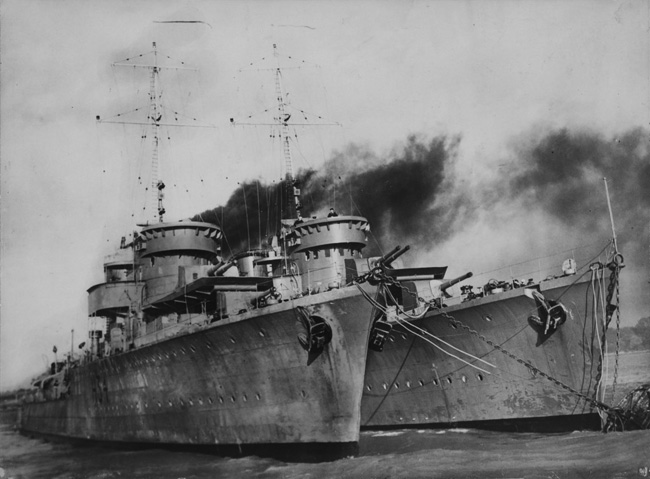
Situation in 1920
In 1920, independent again with a newly liberated territory, Poland quicky constituted a modest fleet composed of heterogeneous ships of the German fleet ceded by the allies and captured Russian ships. Added to this was a division of territory with an enclavement of a region of East Prussia, the famous “Dantzig Corridor” the source of later discontent between neighbours. The Polish fleet was to be adapted to its lesser needs, the land borders representing a danger much more present than the safeguarding and the surveillance of a mere 90 miles of coastal front. This was even more true in 1936, with the advent of Hitler and the Third Reich, and on the other side an increasingly threatening Soviet state. The Poles managed to build a small modern and efficient naval force, with valuable units. If the initial plan of 1920 included 6 torpedo boats, 2 gunboats, 4 minesweepers, and river monitors, the industrial and economic situation was bad enough so that this first plan was never realized.
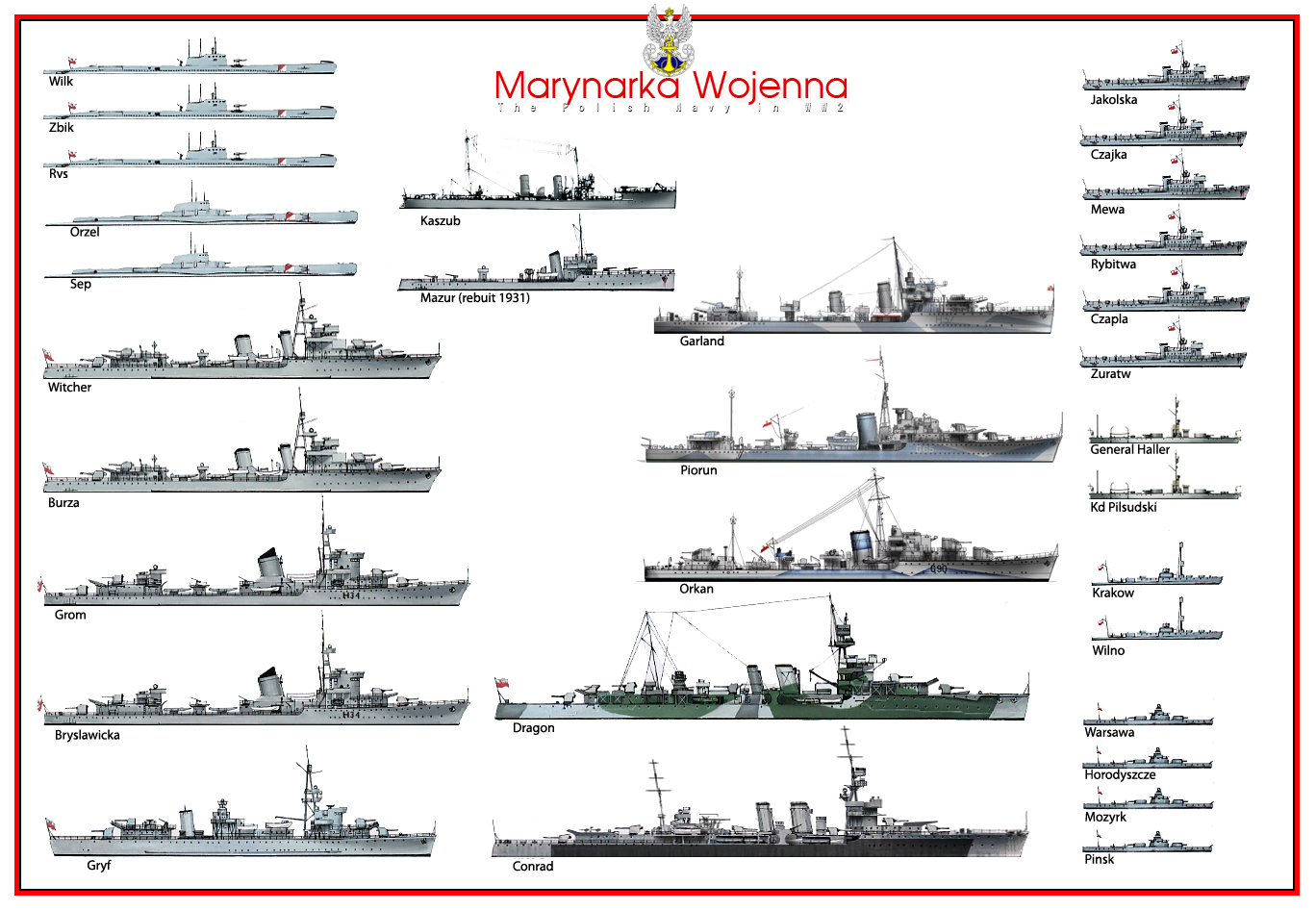
Awaited articles:
Cruiser ORP Dragon
Cruiser ORP Conrad
Grom class Destroyers
Witcher class Destroyers
Minelayer ORP Gryf
Wilk class submersibles
Orzel class submersibles
Jakolska class minesweepers
Polish Monitors
1926 construction program
It was not until 1926 that the “small program” of the KMW (the maritime direction) announced over 12 years the commissioning of 2 cruisers, 6 destroyers, 12 torpedo boats, and 12 submersibles. Particularly important efforts were made for Gdynia Yard to be equipped as a large arsenal (with Brest and Kiel as models), to become the major naval base of the Polish fleet. All of the ships in this program were to be finished by 1940. One of the aspects of the Polish naval policy was the promised intervention of the French Navy in the event of a Russian attack after a defensive alliance was signed in 1921. By mid-1925, however, the 1920 plan was revised and downscaled due to poor economic conditions and budget restrictions. Moreover, due to a lack of sufficient equipment, Gdynia could not ensure the construction of the 4 destroyers and 6 submersibles and finally entrusted their construction to France. The plan was postponed and finally abandoned after the Great Depression of 1929.
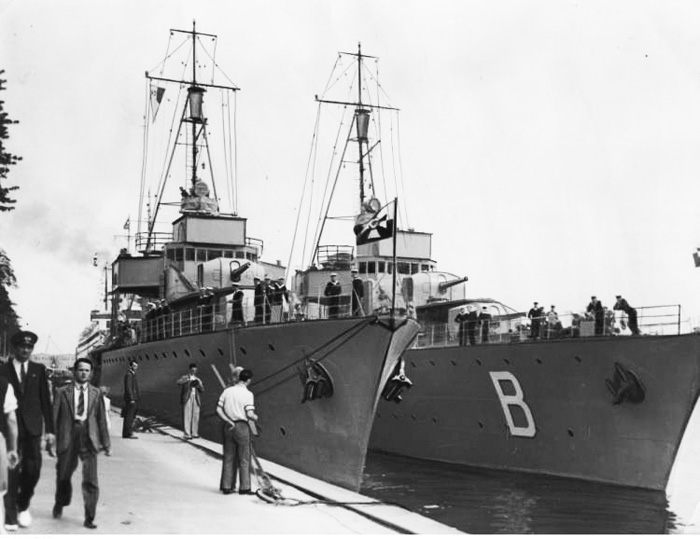
Burza and Wicher, resulting from the 1926 program.
1933 construction program
In 1933, however, the Polish shipyards were able to build several good-quality minesweepers in a short time (unlike the French-ordered destroyers, which were built in 2-3 years). A little later, a large versatile minelayer was ordered from France. Polish authorities then turned to Great Britain. The two ambitious destroyers of the Grom class were so heavily armed (probably among the fastest and most powerful in the world at their completion) that they made up for the abandoned construction of two cruisers. Two large ocean submersibles were also ordered this time from the Dutch, and financed by public subscription.
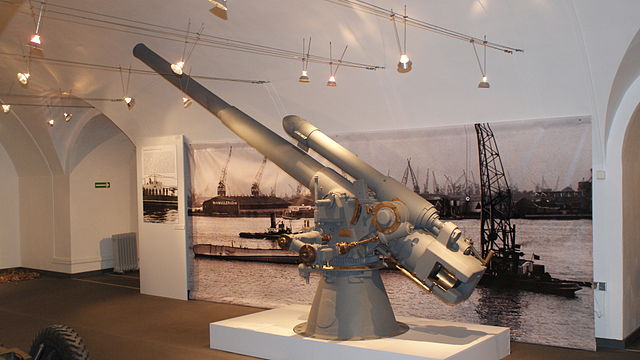
A Polish 105 mm Bofors AA and dual purpose gun
In 1935 Germany reinstated compulsory military service and remilitarized the Rhineland, resulting in a new 6-year program developed by the KMW, including 8 destroyers, 12 submersibles, 12 minesweepers, and 10 torpedo boats. This was coupled with the construction of a huge industrial complex that would be connected with Gdynia and able to give Poland industrial autonomy in the design of the next units. In September 1939, this plan was in progress. At this date, the Polish Navy included about thirty ships which details were as follows:
4 Destroyers: 2 Wicher class, 2 Grom class
4 torpedo boats: Mazur, 3 Podlahanin class
5 Submersible: 3 Wilk class, 2 Orzel class, 2 others under construction in France.
17 Miscellaneous: Minelayer Gryf, 6 Jaskolka class minesweepers, 2 Haller class gunboats, 4 Warsawa class river monitors, 2 Krakow class river monitors.
Polish Navy Operations from September 1939
The Polish Navy in September 1939 was caught mid-expansion. Polish Naval commanders decided to withdraw the main surface fleet, and sail to Great Britain. They decided to join the Allied war effort, preventing a useless scuttling of the fleet come German capture. The Peking Plan saw on 30 August 1939, 3 destroyers (ORP Błyskawica, ORP Grom, and ORP Burza) sailing to the British naval base at Leith in Scotland. Under this plan, they would operate in the future in combination with Royal Navy vessels against Germany. Also, two submarines managed to flee from the Baltic through the Skagerrak, reaching Great Britain soon after. One of them, ORP Orzeł, had at the time been interned in Tallinn, Estonia, under Soviet supervision and traveled without maps to the British Isles. Bar the ships that made it to the Isles, three Polish submarines were interned in neutral Sweden, while the remaining surface vessels were sunk by the Luftwaffe.
Survival: Operation Peking
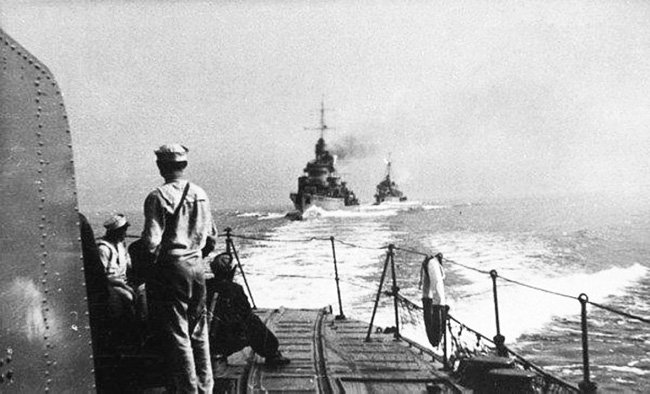
The invasion on Polish soil preceded by the Luftwaffe was also supported by a massive deployment of the Kriegsmarine. The great arsenal of the Westerplatte which supplied the fleet at Gdynia was shelled mercilessly by the old pre-dreadnought Schleswig-Holstein while Stukas flew over all Polish ports, looking for targets: They claimed the Destroyer Wicher, torpedo-boat Mazur, minelayer Gryf, gunboat Haller, 6 minesweepers, and the monitor Milno. These three days of fury also accounted for the destruction of countless installations, fortifications, petrol tanks, facilities, and trains, further making it impossible to organize a coherent response by the ORP.
During these feverish hours, a plan was conceived in collaboration with the British: To prevent the fleet from being destroyed immediately due to the overwhelming air and sea superiority of the Germans, the “Beijing operation” was to order Polish ships to make for British Ports as soon as possible under the protection of the Royal Navy and the RAF after they passed the Straits of Denmark. Thus 3 destroyers and 2 submersibles managed to join the Royal Navy and following an agreement negotiated by Count Raczynski, remained under Polish control but were fully integrated into the Royal Navy.
The Free Polish Navy
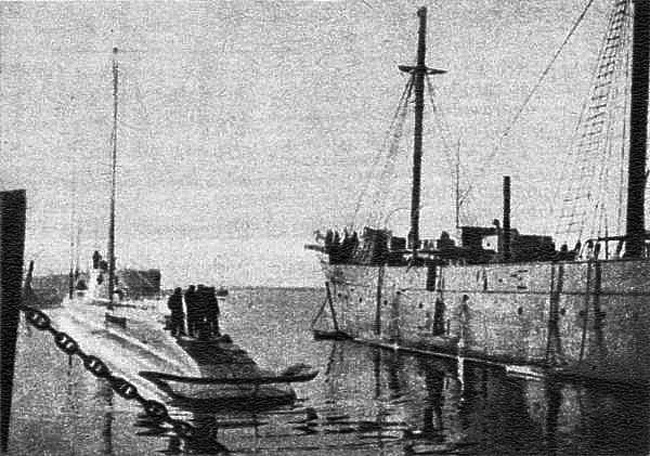
ORP Zbik and Lwow
Shortly after war was declared, three submersibles left for the defense of the Hela Peninsula but did not find German ships to destroy and were forced to escape to Sweden after their country capitulated. They were immobilized there, but one sub, the Orzel escaped and joined the British. Her career was quite successful afterward, sinking the German liner Rio de Janeiro. The “Pinsk Flotilla” in Poland was composed of armored river vessels, stationed on the Vistula. These riverine ships fought against the German forces before falling victim to bombs and field artillery. They were still recoverable but were scuttled in front of the Soviet advance.

Profile of the Orzel
Paradoxically, it was on the nucleus of escaped Polish units that the initial 6-year plan was realized, thanks to particularly generous British transfers during wartime, as volunteers pouring in from the east and eager to fight were decisive in Churchill’s attitude towards the Poles. Not only did they fight with their excellent Grom class destroyers, but were also awarded 6 more destroyers (after Grom’s loss in 1940) Garland, Type G, Hurricane, (ex-French Hurricane captured in 1940), the Piorun (N class), Orkan (M class) and three Hunt class escort destroyers (Krakowiac, Kujawiak, and Slazak) in 1941-42. All these ships performed admirably their tasks within the RN, fighting wherever the Poles were engaged, in the Atlantic, the Channel, the Arctic, or the Mediterranean. But the largest acquisitions of the war were two D-type (1918) light cruisers, the ORP Dragon and Conrad to fill in the gap of the planned cruisers.
The Polish Navy in Detail
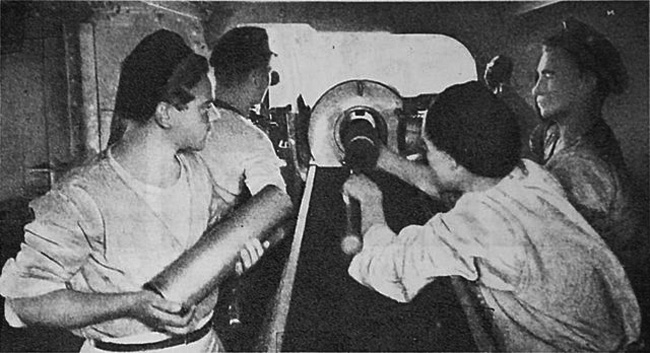
Gunners training on the riverine monitor Wiezy
Since the Polish shore was only 142 km long, there was no need for a blue-water navy, or even for a strong coastal navy. Only a few ships were needed to patrol and repel potential threats. Destroyers were well suited for that, with torpedoes that could cause major damage to any battleship, and a long cruising range. From the initial four naval trawlers and two monitors, the Poles also built nine submarines. The Soviet Union was designated as the main enemy and the Polish fleet was to secure supply convoys from France in case of a war. An economic crisis and the German threat were to wreck the plan, which was abandoned and reduced to three submarines ordered from France.
The Polish Navy in 1939
Grom class destroyers (1936)

ORP Grom in 1940
In the absence of cruisers, many third-rank navies chose to build powerful destroyers. This was the case for Poland with Grom and Błyskawica being built in Great Britain at Cowes. They were launched in 1936 and operational the following year. When they came out, they were the best and fastest destroyers in the world. Their artillery was impressive, with no less than seven guns of 120 mm in twin and single mounts. They also had quad-heavy machine gun positions and Bofors AA, and could carry and lay 44 mines.
Two others, the Orkan and Huragan were started in Gdynia in 1938, but their construction had barely begun when they were captured and dismantled. These two ships, which were the pride of the Polish Navy, however, had to flee at the time of the invasion to avoid both the Stukas and possible capture. It was the “Peking” operation that avoided the useless sacrifice of these units and allowed them to reach the British Isles and from there continue the struggle.
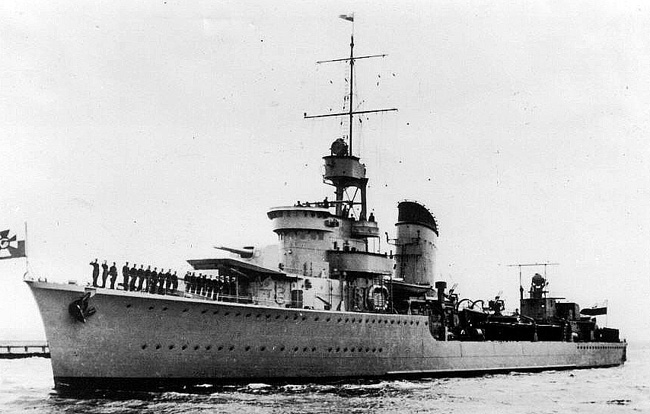
The two destroyers were rearmed, giving up their TT rear bench for a 102 mm AA gun. The Grom operated in Norway in May 1940 and was sank on May 5 by Stukas of Kwg-100. Bryslawicka survived this campaign and was prepared for escort missions. Her 120 mm guns were replaced by four twin mounts of 102 mm AA, plus four 20 mm AA guns and four Bofors 40 mm. In 1942, the 102 mm central lookout was removed and the two TT banks were replaced. A type 271 radar was added. In 1944, Bryslawicka received a Type 291 radar, a 284 firing system, and another Type 293 radar. She was still used intensively until September 1945 and in 1947 became the flagship of the new Polish fleet before being decommissioned in 1965 and preserved. She is currently exhibited at Gdynia.

Błyskawica in the Atlantic
Wicher class destroyers (1936)

The Władysław Grabski government tried to obtain a large credit from France, with French stock owners and the new Caen shipyard, which only stood if it signed a contract with the Poles. On September 9, 1925, the government decided to purchase two destroyers from the Caen shipyard for approximately 22 million złotys. The shipyard presented a plan for two modified Bourrasque-class destroyers and on April 2, 1926, the order was signed.
However, while the yard could deliver blueprints relatively fast, the ships were far from perfect. They were relatively slow, betrayed by a tall silhouette, and handicapped by poor protection. It was revealed later they also had poorly designed watertight compartments and pipelines. Even with minor damage, they could be paralyzed. Stability was also poor due to the placement of the fuel tanks, which were high up on the superstructure. Through this, the shipyard’s lack of experience was showing its true colors. Numerous other construction flaws were corrected after the ships’ delivery by order of the Polish admiralty, but many issues were left unaddressed.
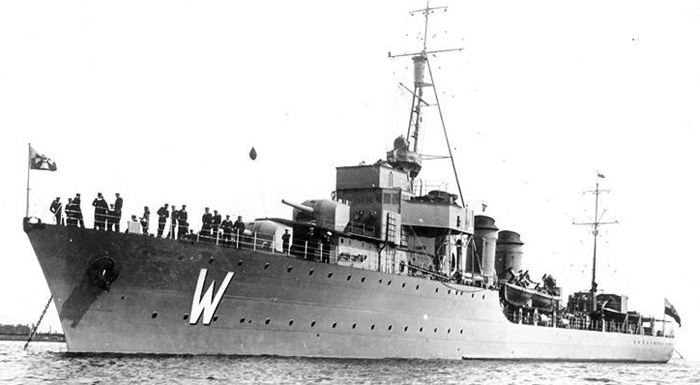
The Wicher class construction took four years, two years above schedule. The steam turbines were provided by Ateliers et Chantiers de la Loire in St. Nazaire. The armament came from the Cherbourg arsenal and Schneider-St Chamond armory. Both ships had the same French standard-issue four 130 mm guns and two triple 550 mm/533 mm/450 mm torpedo tubes banks, but they were complemented by Polish armament, two 40 mm wz. 28 AA Bofors guns, two 240 mm Thornycroft depth charge launchers and two Wz BH200 depth charge launchers, plus two 60 wz. 08 naval mines.
ORP Wicher was eventually launched on July 10, 1928, but was finally commissioned two years later at Cherbourg. Wicher means “gale”, as a continuation of the French naming trend of meteorological events. She arrived at Gdynia and was well covered by the press who were unaware of her limitations, as Polish’s first modern warship. ORP Burza (“storm”), had to wait until 1932, four years after the initial deadline. The construction choices had been mainly political, aiding French financial interests, but left a desperate yard manager and an angry Polish staff as a result. ORP Wicher’s career was short: She was sunk during the first three days of the war by aviation. ORP Burza survived the war however and became a museum ship, scrapped in 1977.
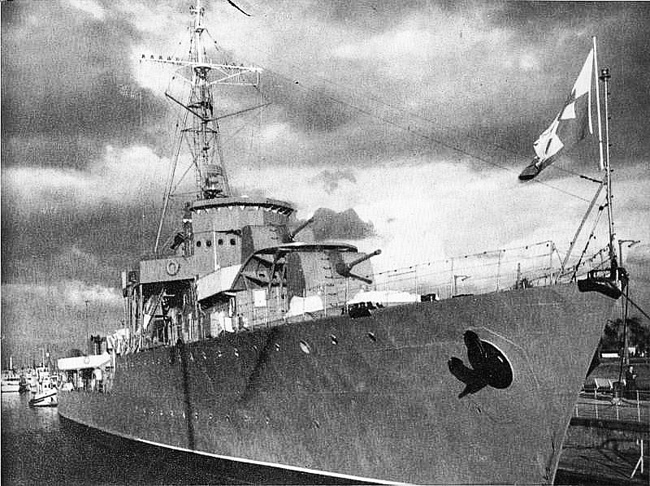
ORP Burza as a museum ship in the 1960s
Specifications
Displacement: 1540t standard
Dimensions: 106.90 x 10.5 x 3.5m
Propulsion: 2 propellers, 2 Loire turbines, 8 Normand Boilers, 6000 hp, 28 knots.
Crew: 162
Armament: 4 x 130 mm, 2 × 40 mm wz. 28 AA guns, 2×3 550 mm/533 mm/450 mm TTs, 2 × 240 mm Thornycroft & 2 × Wz BH200 DCT, 2 × 60 wz. 08 naval mines
Gryf, minelayer destroyer (1936)

This ship was one of the largest in the Polish fleet. She had been designed for a wide variety of tasks but served a disappointing peacetime career as a training ship and presidential yacht. Designed in France by Augustin Normand, she was heavily armed and rolled a lot, with a high metacentric height. In addition, she was too cramped and underpowered. Operational in February 1938, she was attacked and struck on 1 September by the German Luftwaffe. She then served as a floating battery in Hela before being bombed on September 3 and sunk for good. Part of her armament was later recovered to reinforce Hela’s defense. The Germans towed the hull to Gdansk and she served as a training target before being finally raised well after the war and sent to shipbreakers in 1964.

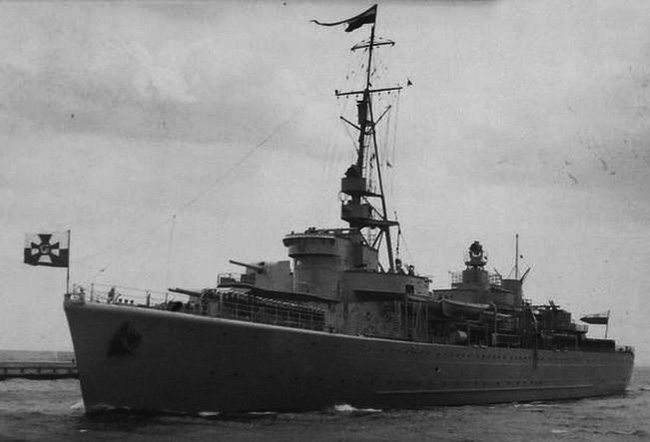
Specifications
Displacement: 2250t, 2900t FL
Dimensions: 103.20 x 13.1 x 3.6m
Propulsion: 2 propellers, 2 Sulzer diesels and 6000 hp, 20 knots.
Crew: 205
Armament: 6 x 120 mm (2×1, 2×2), 4 Bofors 40 mm AA (2×2), 4 MG 13,2 mm (2×2), 60 mines.
Wilk class submarines (1929)

ORP Wilk in 1939
These were French-built Normand-Fenaux type minelayer submarines. The Rys (1929), Wilk (1929) and Zbik (1931) came from AC de la loire, nantes, Augustin Normand and CNF. They were derived from the Saphir class, longer, with a 260 ft diving limit and a range of 2500 nautical miles at 10 knots. Of double hull configuration, they carried 40 mines in ten separate wells, each with four mines. But the system proved unreliable. While they were good sea boats they were also noisy and left oil trails. Armament-wise, in addition to the minelaying tubes they had four bow TTs and two trainable external TTs further aft.
In addition to a 100 mm/40 gun on the forward deck, they also carried a 40 mm bofors behind the kiosk for AA defense, replaced later by a twin 13.2 mm heavy MG mount. After the war broke out, none could escape to the UK due to their limited range. Rys and Zbik took refuge in the Swedish port of Stavnas, later joined by Sep. All three were transferred to Loch Malar. Only Wilk managed to escape through the Skagerrak and join the Royal Navy, but served only until 1942, because of the lack of spare parts and her age and condition. The two others were returned to Poland and scrapped in the 1950s.
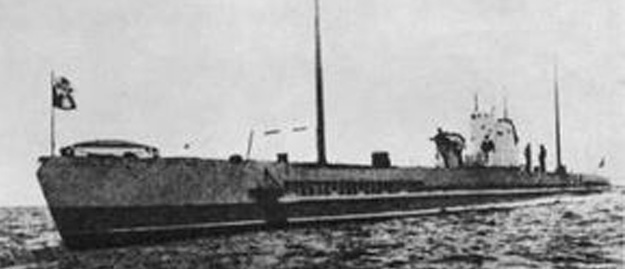
ORP Rys
Specifications
Displacement: 980t, 1250t FL
Dimensions: 78.5 x 5.9 x 4.2m
Propulsion: 2 shaft Normand-Vickers diesels, 2 emevtric motors and 1800/1200 hp, 14/9 knots.
Crew: 54
Armament: 6 x 550 mm (6, 1×2) TTs, 100 mm/40, Bofors 40 mm AA, 40 mines.

Orzel class submarines (1938)
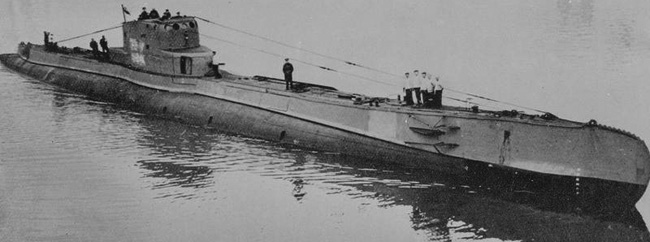
The best Polish submarines by a fair margin were the two long-range cruisers built in the Netherlands at De Schelde and Rotterdam. They were 1400 tons, 84 m (275 feet) long boats tailored to attack German shipping in the Baltic and beyond. They were built by a public subscription raised in 1935. These were large oceanic types with excellent fighting qualities, carrying a double hull type with five compartments. They could dive beyond 270 feet and had a 7000 nautical mile range at 10 knots. Orzel was commissioned in February of 1939, and arrived at Gdynia in April 1939 but made her trials in a hurry to avoid German sabotage in the Netherlands.
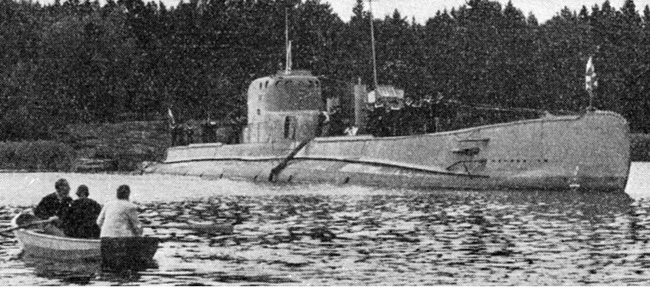
ORP Sep in 1939
However, her sister-ship Sep was not ready in September and was interned at Stavnas, while Orzel was interned at Tallinn. She saw all her documents confiscated but later managed to sail off into the Baltic in December, later making it to the UK. From there, she started a new wartime career. Her escape to Rosyth was applauded as she passed through German minefields and air and ASW patrols. She managed to sink the German steamer Rio de Janeiro but was ultimately lost probably because of a mine in the north sea in June 1940. Her sister, Sep, remained inactive during the war and returned to Poland in 1945.
There was a modified Orzel class on paper by 1939. Both submersibles were to be built in France, at AC Augustin Normand and Loire, both of a modified Orzel type, with a 1550 tons displacement when diving, 87 m long, armed with twelve 550 mm tubes (four bow, four stern and two twin trainable banks on the surface), 20 torpedoes in store, two twin Bofors and possibly a single twin 13.2 mm heavy MG. Work was suspended in April 1939 and the hulls were later destroyed by the Germans to free the slipways.

Specifications
Displacement: 1100t, 1473t FL
Dimensions: 84 x 6.7 x 4.17
Propulsion: 2 shaft Sulzer diesels, 2 Brown-Boveri electric motors and 4740/1100 hp, 20/9 knots.
Crew: 60
Armament: 12 x 550 mm (4 bow, 4 stern, 2×2 pressure hull) TTs, 105 mm/41, 1×2 Bofors 40 mm AA, 1×2 13.2 mm MG

Jaskolka class minesweepers (1939)

Six new minesweepers were in service in September 1939. Their construction began in Modlin and Gdynia in 1933 and ended in 1938 with the admission of the final ship, the Zuraw. They were solid units, but were slow and weakly defended. The six ships were stationed in Gdynia in September 1939 and were attacked by the Luftwaffe and seriously damaged or sunk and permanently lost. Four were salvaged, repaired, and returned to service under German supervision as TFA 11, 7, and 8, escaping destruction. Their retrocession took place in 1946, only to be scrapped in 1960.
Specifications
Displacement: 183t
Dimensions: 45 x 5.5 x 1.37 m
Propulsion: 2 propellers, 2 Nohab diesels and 1040 hp, 17.5 knots.
Crew: 30
Armament: 1x 76 mm gun, 2x MG 13.2 mm, 30 mines.
Polish Monitors (1920-25)

The Polish River Monitors numbered six in September 1939. The first four and older were those of the Warsawa class, including the Horodyszcze, Torun, Pinsk, and Warsawa. They had been built in 1920 at Danziger Werft shipyards to serve on the Vistula and its tributaries, protecting eastern Poland against Russian appetites. They were then the spearhead of the “Pinsk Flotilla”. Originally they were armed with two 105 mm guns and 5 machine guns in turrets. Fully armored, they had a small superstructure and a lookout mast. However, in 1928 they were rearmed with a 100 mm howitzer and two pieces of 75 mm, four AA machine guns. Between 1936 and 1939 they were rebuilt and their silhouette was lowered, their engines changed for two Glennifer models that produced 100 hp. Three 75 mm turret pieces were mounted while four turret machine guns were installed on a central armored casemate. On September 1, 1939, they scuttled without fighting on the Prypec and were captured and renamed by the Russians who in 1941 used them against the German invasion. They were scuttled to avoid capture.
Displacement: 110t, 130 t FL
Dimensions: 34.5 x 5.1 x 0.7 m
Propulsion: 2 propellers, 2 Glennifer diesels 4 cylinders and 200 hp, 11 knots.
Armour: Max 11 mm
Crew: 38
Armament: 3 x 75 mm (3in), 4 x 13,2 mm MGs.
The Krakow class monitors were a bit more recent, and these two being built at the Zelnewskiego shipyard in 1924-26 and were assigned to the Pinsk flotilla. Originally, their weaponry included a 100 mm turret Howitzer at the rear and two 75 mm central turret pieces with a 360-degree firing arc, and four turreted machine guns. In 1932, the two 75 mm pieces were replaced by 100 mm Howitzers. In 1939, they were given added 4 machine guns in double turrets. The Krakow was scuttled on the Prypec near Kuzliczyn on September 21, 1939, and the Wilno was sunk near Osobowicze on the 19th. The Krakow was later captured by the Russians, renamed Bobruisk, and was part of the Pinsk flotilla. It was bombed and sunk during Operation Barbarossa in 1941.
Caracteristics Krakow:
Displacement: 80t, 110 t FL
Dimensions: 35 x 6 x 0,39 m
Propulsion: 2 propellers, 2 diesels PK 120 hp, 7,5 knots.
Armour: 5-8 mm
Crew: 32
Armament: 3 Howitzer 100 mm, 8 x 13,2 mm MGs.
Kaszub class TBs (1914)

Of the six torpedo boats owned by Poland in 1920alongside the ones they acquired from a recently defeated Germany, four were of type A56 and dated to 1918. Displacing 381 tons, there were only three in 1939 as Krakowiak was scrapped in 1937. Capable of reaching 28 knots, they were armed with two 88 mm guns and a single 450 mm TT that could be reloaded. They were captured at berth in 1939 but were not destroyed nor presumably used by the Kriegsmarine. Two other torpedo boats of type V105 (1914) had also been in service, the Kaszub being badly damaged during a storm on July 20, 1925. Subsequently, the Mazur was completely rebuilt to serve as a gunnery training ship, while her torpedo tubes and the 88 mm main gun were deposed for four 76 mm (3 in). Her machinery was renovated, but she was sunk by the Luftwaffe during the first hours of the German attack, becoming, on September 1st, the first ship sunk during the Second World War.

Specifications (Mazur 1939)
Displacement: 350t, 440 t FL
Dimensions: 62 x 6,2 x 2,60 m
Propulsion: 2 shaft 2 Vulkan AEG turbines, 4500 hp, 25 knots.
Crew: 57
Armament: 4 x 76 mm (3 in).
The Free Polish Navy (1941-45)
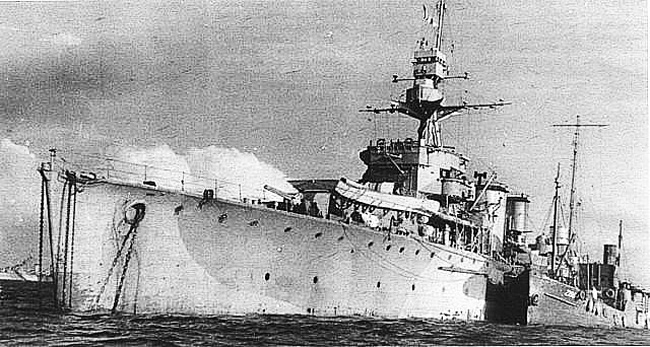
During the war, the Polish Navy in exile was supplemented with leased British ships, including two cruisers, seven destroyers, three submarines, and several smaller fast-attack vessels. The Polish Navy fought alongside the Allied navies in Norway, the North Sea, the Atlantic, and the Mediterranean, and aided in the escort of Atlantic and Arctic convoys, in which ORP Orkan was lost in 1943. Polish naval vessels played a part in the sinking of the German battleship Bismarck, and in the landings in Normandy during D-Day.
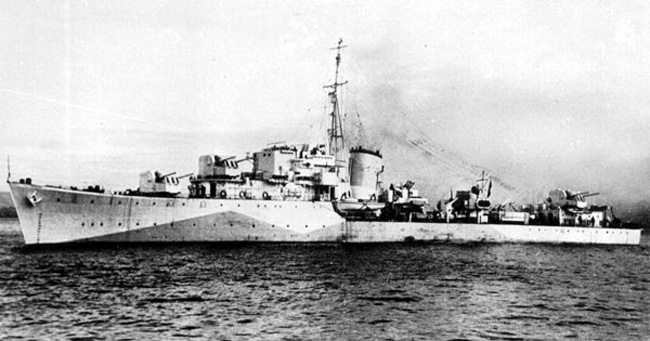
ORP Orkan in 1943
During the course of the war, one cruiser, four destroyers, one minelayer, one torpedo boat, two submarines, and some smaller vessels (gunboats, mine hunters etc.) were sunk; in total, twenty-six ships were lost, mostly in September 1939. In addition to participating in the sinking of Bismarck, the Polish Navy sank an enemy destroyer and six other surface ships, two submarines, and a number of merchant vessels.
The most important transfers into the navy were those of the ORP Dragon in 1943 (ex-HMS Dragon) and Conrad, ex-Danae in 1944, after the loss of the first. They were also the submersible Jastrzab, ex-S25 American, an ancient unit transferred to the British under the “lend-lease” device, and which was sent to escort convoys of the Arctic. Two more important submarine transfers were that o the Dzik and Sokol, which operated successfully in the Mediterranean against the Italian convoys and gained the nickname of “terrible twins”. There were also 10 torpedo boats transferred to the summer (Type MTB White and Type MGB) and for one year, two French submarine fighters which had been captured in Great Britain in July 1940.
D class cruisers

ORP Dragon in 1944
The Polish Navy did not have any cruisers in 1939. Most of her ships were destroyed or took refuge in Great Britain. Afterward, some ships resumed service under Polish colors but were fully integrated into the Royal Navy. As more and more Polish seamen also took refuge in the UK and were available for action at sea, the British chose to give two cruisers to the Poles, the Conrad, and Dragon. They were not in service simultaneously: The first into service was ORP Dragon, ex-HMS Dragon. Both ships were light cruisers of the class “D” of 1918.
They had their main artillery in simple shielded mounts but their armament was supplemented by modern torpedo tube banks, along with updated AAA. In addition, radar, a huff-duff antenna, a sonar room, and ASW grenade launchers were installed. The official transfer was done on January 15, 1943. ORP Dragon was sunk on July 8, 1944, off the Normandy coast, supporting supply operations of the beachheads, by a human torpedo of the Neger type. Judged as irreparable, she was towed away and finally sunk to form a breakwater in front of one of the artificial ports of the coast.

ORP Conrad
On October 4, 1944, the Royal Navy gave the Poles the former HMS Danae of the same class, renamed ORP Conrad, with the same modifications. She served intensively until the end of the war and was sent back to Great Britain on September 26, 1946, to be shortly after broken up.
Specificatons
Displacement: 4990t, 6100t FL
Dimensions: 143.6 x 13.9 x 5 m
Propulsion: 2 propellers, 2 Brown-Curtis turbines, 6 Yarrow boilers, 40,000 hp, 29 knots.
Crew: 480
Armament: 5 x 152 mm, 12 x TLT 533 mm (4×3), 16 x 40 mm AA (4×4) Bofors AA.
ORP Garland: A “G” class destroyer transferred in May 1840, loaned by the Royal Navy, she kept her name. She served until the end of the war and was returned to the UK in 1946.
ORP Ouragan: The former French Ouragan was seized in a British port after the fall of France. She was roughly of the same type as the Wicher class, and thus assisted in the training of Polish crews. She survived the war and returned to the Royal Navy in April 1941.
ORP Piorun: An “N” class destroyer, former HMS Nerissa, she was transferred on 5.11.1940 to compensate for the loss of Grom. She served well during wartime and was returned in 1946.
Already on drydocks for repairs, she took part in the defense of the Clydebank against the Luftwaffe in March 1941. In May, she joined the British 4th Destroyer Flotilla (Cossack, Maori, Sikh, and Zulu, Captain Philip Vian) to escort the troop convoy WS8B from Glasgow to the Indian Ocean. On 25 May, this force was hastily detached to join the hunt for the German battleship Bismarck in the Atlantic.
Piorun eventually spotted the battleship, shadowing her and leading torpedo attacks the night before she was sunk. She operated in pairs with HMS Maori, charging at Bismarck to draw fire while Maori maneuvered to fire her torpedoes. Piorun dueled with Bismarck for an hour, without being hit, although a near miss at 20 yards (18 m) made Piorun brake the duel and retire. Piorun also participated in Operation Halberd (Malta convoys), and Operation Husky (Sicily). She returned to the Home Fleet in 1944, and participated in Operation Deadlight, sinking several captured German Type XXI submarines.
ORP Orkan: An M-class destroyer, being a wartime repeat of the preceding L class, and originally named HMS Myrmidon, she was built in Scotland in 1942. She was transferred to the free Polish navy in December 1942. ORP Orkan served in the Arctic, mainly based in Murmansk. Early in 1943, she had successfully escorted the convoy JW-53 to Russia, along with the return convoy RA-52. She patrolled and was also a convoy escort in the North Atlantic. In July of the same year, she transferred the body of Władysław Sikorski from Gibraltar to England. However, on October 8, she was torpedoed and sank at 07.05 hours by a GNAT homing torpedo fired from U-378. She was escorting the convoy SC 143. One officer and 43 men survived, thanks to the quick and risky intervention of HMS Musketeer.
This type of destroyer was armed with three twin 4.7 in (120 mm) Mk XI dual-purpose guns, a single QF 4 in (102 mm) Mk V anti-aircraft gun a quadruple QF 2-pdr (40 mm) Mk VIII AA “pom pom” gun mount, and two single Oerlikon 20 mm (0.8 in) AA guns plus two quadruple, and two twin 0.5 in (12.7 mm) Vickers Mark III anti-aircraft machineguns. Torpedoes were reduced to a single quadruple 21 in (533 mm) bank but she also carried 42 depth charges, two racks, and two DC throwers for ASW warfare, which reflected the priorities already in 1941 when the Type M plans were first drafted.
Other transfers
-Submarine Jastrzab: Former US-built S25, she has been at first transferred to the RN to evaluate the adoption of WW1-vintage surplus American types. At the time, the crew of Wilk (lost) was available, and it was decided in 1941 to transfer the boat to the Poles and renamed her. Jastrzab screened the convoy PQ but was sunk later by an error by the Norwegian destroyer St Albans and British Seagull on 2.5.1942.
-Dzik class submarines: The “terrible twins” were ex-U class submarines Urchin and P52 transferred on 11.10.1942. Both served in the Mediterranean. Dzik was used from December 1944 as a training submarine, joined later by ORP Sokol.
-S1 class MTB: Two motor torpedo boats built by public subscription at White, Cowes in March 1940, and the first was ceded as S1 to the Poles in August 1940, returned in February 1944.
-S2 class MTB: Two ASW power boats intended for the RN as MGB44 and 45, transferred in July 1940 and commissioned as S2 Wilczur and S3 Wysel. The first was discarded in 1943 and the second in 1944.
-S4, S5 class MTBs: In total, six more MTBs were transferred in 1943 and 1944. They were renamed S4-S10 and returned in 1944 or 1945.
-CH11 sub-chasers: Ex-French sub-chasers which took refuge in England after the French capitulation, they were interned and later ceded to the Poles on 19.7.1940. after some service, they were returned in February 1941.
Read More
https://sites.google.com/site/secondpolishrepublik/mis-articulos/chapter-09
https://en.wikipedia.org/wiki/Polish_Navy_order_of_battle_in_1939
https://en.wikipedia.org/wiki/Order_of_Battle_of_the_Riverine_Flotilla_of_the_Polish_Navy
http://hmscavalier.org.uk/G90/ About the ORP Orkan
https://en.wikipedia.org/wiki/ORP_Burza
https://en.wikipedia.org/wiki/Grom-class_destroyer
https://en.wikipedia.org/wiki/Peking_Plan
https://en.wikipedia.org/wiki/ORP_Wilk_(1929)

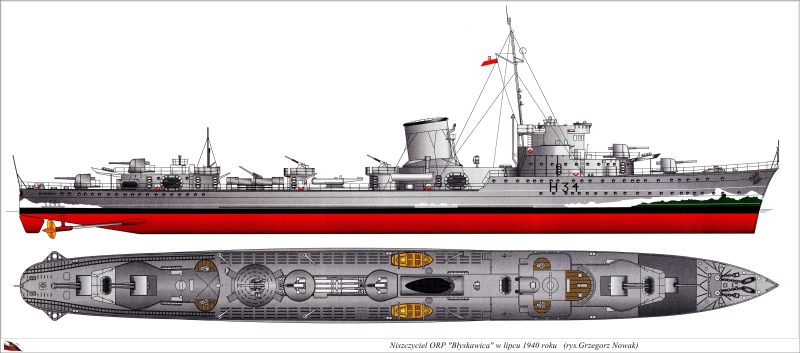
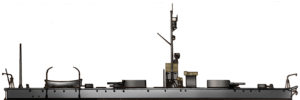
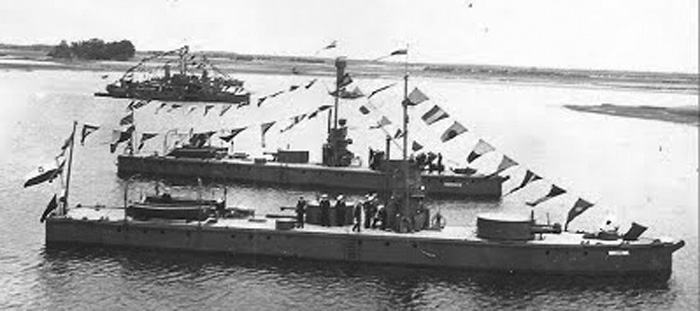
 Latest Facebook Entry -
Latest Facebook Entry -  X(Tweeter) Naval Encyclopedia's deck archive
X(Tweeter) Naval Encyclopedia's deck archive Instagram (@navalencyc)
Instagram (@navalencyc)





 French Navy
French Navy Royal Navy
Royal Navy Russian Navy
Russian Navy Armada Espanola
Armada Espanola Austrian Navy
Austrian Navy K.u.K. Kriegsmarine
K.u.K. Kriegsmarine Dansk Marine
Dansk Marine Nautiko Hellenon
Nautiko Hellenon Koninklije Marine 1870
Koninklije Marine 1870 Marinha do Brasil
Marinha do Brasil Osmanlı Donanması
Osmanlı Donanması Marina Do Peru
Marina Do Peru Marinha do Portugal
Marinha do Portugal Regia Marina 1870
Regia Marina 1870 Nihhon Kaigun 1870
Nihhon Kaigun 1870 Preußische Marine 1870
Preußische Marine 1870 Russkiy Flot 1870
Russkiy Flot 1870 Svenska marinen
Svenska marinen Søværnet
Søværnet Union Navy
Union Navy Confederate Navy
Confederate Navy Armada de Argentina
Armada de Argentina Imperial Chinese Navy
Imperial Chinese Navy Marinha do Portugal
Marinha do Portugal Mexico
Mexico Kaiserliche Marine
Kaiserliche Marine 1898 US Navy
1898 US Navy Sovietskiy Flot
Sovietskiy Flot Royal Canadian Navy
Royal Canadian Navy Royal Australian Navy
Royal Australian Navy RNZN Fleet
RNZN Fleet Chinese Navy 1937
Chinese Navy 1937 Kriegsmarine
Kriegsmarine Chilean Navy
Chilean Navy Danish Navy
Danish Navy Finnish Navy
Finnish Navy Hellenic Navy
Hellenic Navy Polish Navy
Polish Navy Romanian Navy
Romanian Navy Turkish Navy
Turkish Navy Royal Yugoslav Navy
Royal Yugoslav Navy Royal Thai Navy
Royal Thai Navy Minor Navies
Minor Navies Albania
Albania Austria
Austria Belgium
Belgium Columbia
Columbia Costa Rica
Costa Rica Cuba
Cuba Czechoslovakia
Czechoslovakia Dominican Republic
Dominican Republic Haiti
Haiti Hungary
Hungary Honduras
Honduras Estonia
Estonia Iceland
Iceland Eire
Eire Equador
Equador Iran
Iran Iraq
Iraq Latvia
Latvia Liberia
Liberia Lithuania
Lithuania Mandchukuo
Mandchukuo Morocco
Morocco Nicaragua
Nicaragua Persia
Persia San Salvador
San Salvador Sarawak
Sarawak Uruguay
Uruguay Venezuela
Venezuela Zanzibar
Zanzibar Warsaw Pact Navies
Warsaw Pact Navies Bulgaria
Bulgaria Hungary
Hungary

 Bundesmarine
Bundesmarine Dutch Navy
Dutch Navy Hellenic Navy
Hellenic Navy Marina Militare
Marina Militare Yugoslav Navy
Yugoslav Navy Chinese Navy
Chinese Navy Indian Navy
Indian Navy Indonesian Navy
Indonesian Navy JMSDF
JMSDF North Korean Navy
North Korean Navy Pakistani Navy
Pakistani Navy Philippines Navy
Philippines Navy ROKN
ROKN Rep. of Singapore Navy
Rep. of Singapore Navy Taiwanese Navy
Taiwanese Navy IDF Navy
IDF Navy Saudi Navy
Saudi Navy Royal New Zealand Navy
Royal New Zealand Navy Egyptian Navy
Egyptian Navy South African Navy
South African Navy






























 Ukrainian Navy
Ukrainian Navy dbodesign
dbodesign